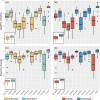Fungal sporocarps house diverse and host-specific communities of fungicolous fungi
- PMID: 33432137
- PMCID: PMC8115690
- DOI: 10.1038/s41396-020-00862-1
Fungal sporocarps house diverse and host-specific communities of fungicolous fungi
Abstract
Sporocarps (fruit bodies) are the sexual reproductive stage in the life cycle of many fungi. They are highly nutritious and consequently vulnerable to grazing by birds and small mammals, and invertebrates, and can be infected by microbial and fungal parasites and pathogens. The complexity of communities thriving inside sporocarps is largely unknown. In this study, we revealed the diversity, taxonomic composition and host preference of fungicolous fungi (i.e., fungi that feed on other fungi) in sporocarps. We carried out DNA metabarcoding of the ITS2 region from 176 sporocarps of 11 wood-decay fungal host species, all collected within a forest in northeast Finland. We assessed the influence of sporocarp traits, such as lifespan, morphology and size, on the fungicolous fungal community. The level of colonisation by fungicolous fungi, measured as the proportion of non-host ITS2 reads, varied between 2.8-39.8% across the 11 host species and was largely dominated by Ascomycota. Host species was the major determinant of the community composition and diversity of fungicolous fungi, suggesting that host adaptation is important for many fungicolous fungi. Furthermore, the alpha diversity was consistently higher in short-lived and resupinate sporocarps compared to long-lived and pileate ones, perhaps due to a more hostile environment for fungal growth in the latter too. The fungicolous fungi represented numerous lineages in the fungal tree of life, among which a significant portion was poorly represented with reference sequences in databases.
Conflict of interest statement
The authors declare that they have no conflict of interest.
Figures




References
-
- Kües U, Khonsuntia W, Subba S. Complex fungi. Fungal Biol. Rev. 2018;32:205–18.
-
- Halbwachs H, Simmel J, Bässler C. Tales and mysteries of fungal fruiting: how morphological and physiological traits affect a pileate lifestyle. Fungal Biol Rev. 2016;30:36–61.
Publication types
MeSH terms
Substances
Associated data
Grants and funding
LinkOut - more resources
Full Text Sources
Other Literature Sources

